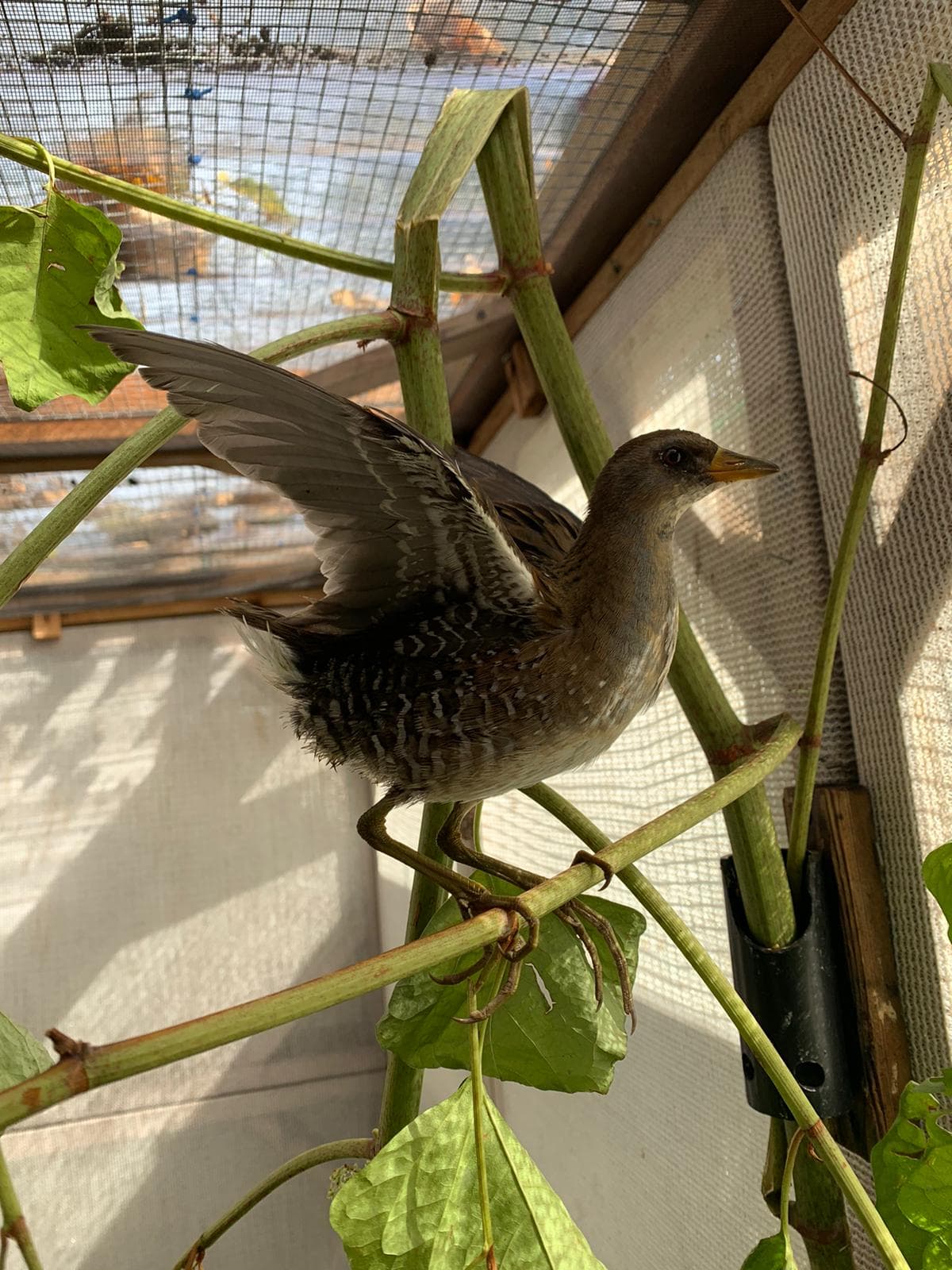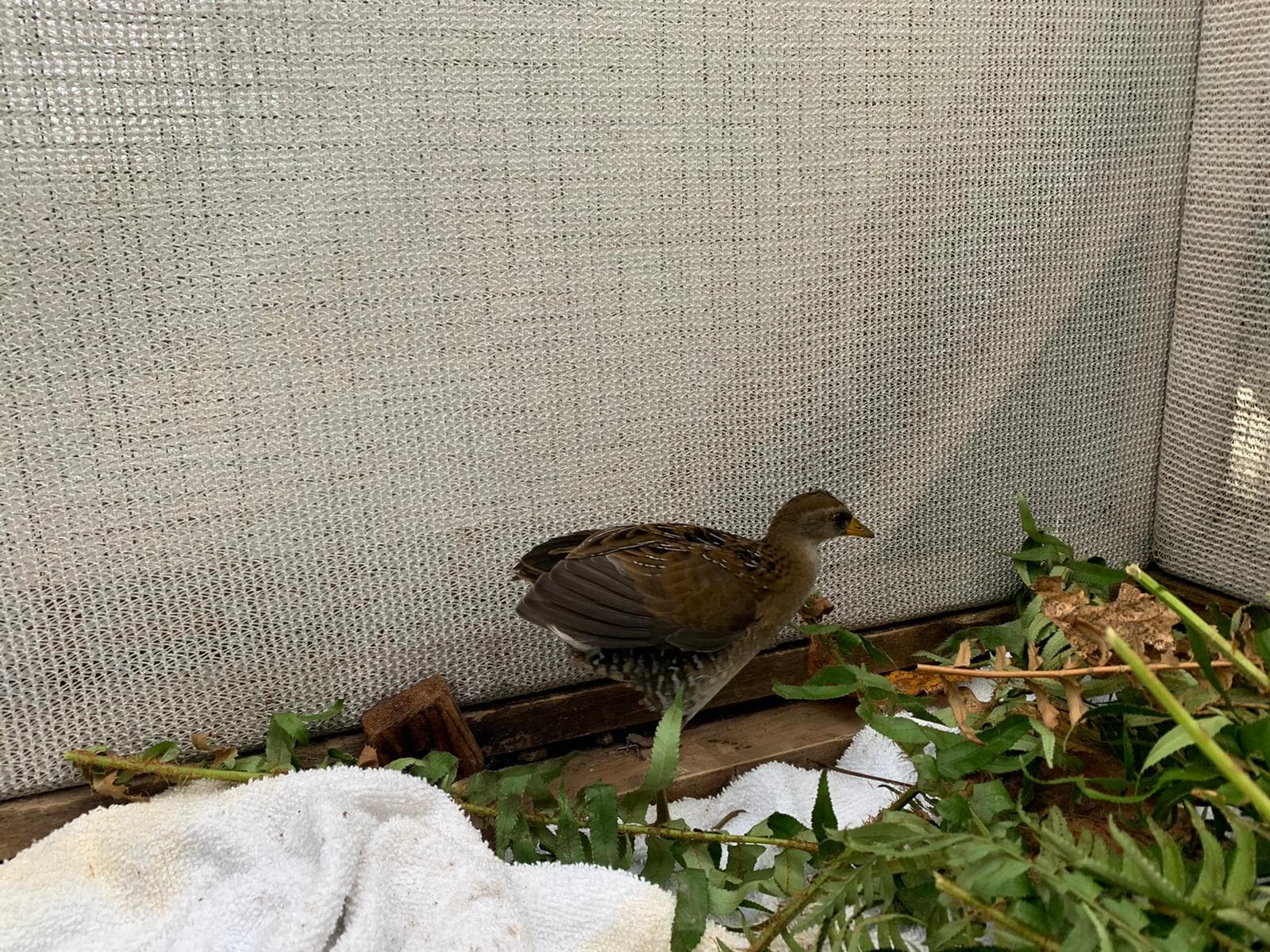Support Us
Since 1979 more than 140,000 animals have been treated by Wildlife Rescue.
Thanks to the support of individuals like you, Wildlife Rescue can provide a lifeline for animals in distress.
The Sora is a small waterbird of the family Rallidae, sometimes referred to as the sora rail or sora crake. This small chicken-like bird is chubby with uniquely long toes that help it to tackle floating vegetation when searching for food. Soras are grayish-brown with white-edged feathers, a dark throat patch with vertical white lines, a black mask from the bill to the eye and a white patch under the tail. The bill is bright yellow which might make you think of Halloween candy corns.

These unique birds are frequently seen on shallow wetlands and marshy areas amid dense vegetation, foraging for food either early in the morning or late in the evening. These habitats provide a rich diet of wetland plants, aquatic invertebrates, grass, rice and smartweed. These birds also peck at small insects such as snails, dragonflies and beetles. Sora makes its presence known with its distinct whistles and whinnies. It is rare for a birder to see a Sora out in the open but when you do, it is worth catching a quick glimpse of before it quickly vanishes.
Soras nest at the edges of shallow wetlands (less than about 8 inches deep) in dense patches of cattails and sedges. Both partners help build a nest either on top of vegetation or attached to plant stems above the surface of the water. The female loosely weaves together a shallow basket that is about 6 inches wide and as she builds, the male brings vegetation for the nest. As soon as the nest is complete the female starts to lay her eggs and continues to add material to the nest, adding layers of protection for her hatchlings.
A full clutch is usually about 10-12 eggs and incubated by both parents for approximately 18-20 days. The eggs do not hatch at the same time because incubation begins shortly after the first few eggs are laid. In these situations, one parent provides care for the hatchlings while the other continues to incubate the remaining eggs. The young usually leave their nest shortly after hatching and take their first flight at around 20-25 days.
Sora Caught by Cat Survives!
On September 16th, an onlooker found an adult Sora on the side of the road after a neighbor’s cat caught the adult bird in its mouth. Although the bird appeared to be healthy with no visible injuries, the onlooker took safety precautions and immediately brought this bird to Wildlife Rescue hospital for assessment. The Sora was in good body condition, alert and well hydrated but required preventative treatment in case the cat transferred bacteria from its claws or mouth through a bite.
Sometimes, non-visible injuries can be missed and are important to address especially when involving bites, cuts and wounds to the animal. Wildlife Rescue provided a prophylaxis antibiotic treatment that helps prevent infections and ensured the Sora completed the entire treatment. This would allow staff to see if any infections were present that were not caught during the assessment.
Cats carry bacteria (Pasteurella multocida) in their mouth and often in their claws. If a cat were to bite the bird and create a small puncture it can go unnoticed because of how small, it may be. This wound from a small bite or claw allows for a perfect environment for bacteria growth. Once this happens the bacteria can spread and cause infections, septicemia, and death if the patient is left untreated. Sometimes the window for treatment is critical after a cat attack. If the window is missed the animal will show symptoms such as skin infections, blood poisoning and even disorientation.
The Sora responded well to treatment and Wildlife Staff did not see any emerging skin infection during the care. Because the Sora was already in great body condition and well flighted, it was important for the staff to put together a release plan because these birds don’t do well in captivity for long.

Sora’s are prey species, often hidden in dense vegetation. For them to survive they require similar vegetation to reduce stress and encourage self-feeding. If these birds feel their environment does not fulfill their needs they can become stressed. This can include a proper diet, dishes, enclosure, and enrichment. If these environmental factors are missing the Sora will stop eating and would succumb to their injuries. These delicate precautions for this bird are important to ensure a safe release to the wild.
Wildlife Rescue provided an enclosure with canopies and hiding places to reducing its stress while in care. Staff was cautioned to move around slowly and avoid loud sounds like talking and background noises. The feedings were provided in shallow flat dishes that the bird could stand in with rich natural foods like insects, seeds, and mud trays with live insects.
The Sora was released in a safe location nearby, without any cats. He flew into the trees immediately, hiding and exhibiting natural behavior. A true success story for Wildlife Rescue.
Tips to Assess if Wildlife Attacked by a Cat:
Soras are common and the most abundant rail species in North America. Their population was stable between 1966 and 2015 according to the North American Breeding Bird Survey. While Sora populations are stable right now, they are at risk due to declining wetland habitats, because of urban and agricultural development. Another cause of decline is their night migration that presents challenges in the air and frequently results in collisions with lighted towers.
If you see a bird or animal in distress, please contact our Support Centre for assistance. Thank you for saving your local wildlife.
Help Save Your Local Wildlife Today!